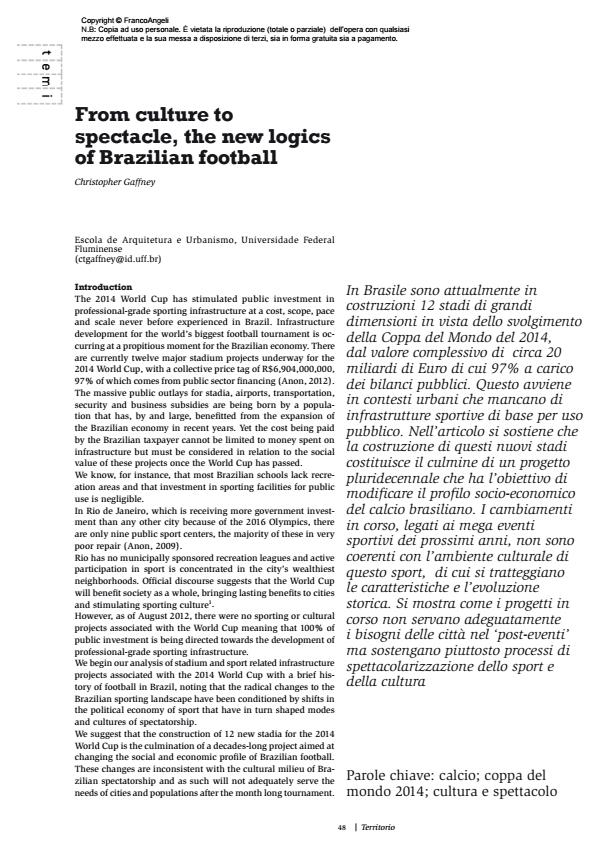From culture to spectacle, the new logics of Brazilian football
Titolo Rivista TERRITORIO
Autori/Curatori Christopher Gaffney
Anno di pubblicazione 2013 Fascicolo 2013/64
Lingua Italiano Numero pagine 6 P. 48-53 Dimensione file 264 KB
DOI 10.3280/TR2013-064008
Il DOI è il codice a barre della proprietà intellettuale: per saperne di più
clicca qui
Qui sotto puoi vedere in anteprima la prima pagina di questo articolo.
Se questo articolo ti interessa, lo puoi acquistare (e scaricare in formato pdf) seguendo le facili indicazioni per acquistare il download credit. Acquista Download Credits per scaricare questo Articolo in formato PDF

FrancoAngeli è membro della Publishers International Linking Association, Inc (PILA)associazione indipendente e non profit per facilitare (attraverso i servizi tecnologici implementati da CrossRef.org) l’accesso degli studiosi ai contenuti digitali nelle pubblicazioni professionali e scientifiche
Twelve large size stadiums are currently under construction in Brazil to host the 2014 World Cup for a total cost of around Euro 20 billion of which 97% met by public funding. This is taking place in urban contexts that are lacking in basic sports facilities for public use. The paper holds that the construction of these new stadiums constitutes the culmination of a project lasting several decades, the objective of which is to change the socio-economic profile of Brazilian football. The changes in progress relating to the mega sports events to be held in the next few years are not compatible with the cultural environment of this sport; an outline is given of its nature and history. It is shown that the projects underway do not adequately meet the needs of the city after the events, but rather support processes to further commercialise the sport and its culture from a show business viewpoint.
Parole chiave:Football; 2014 World Cup; culture and show business
- Virando o jogo Christopher Gaffney, in Journal of Sport and Social Issues /2015 pp.155
DOI: 10.1177/0193723513515887 - The ambiguous labour of hope: Affective governance and the struggles of displaced street vendors in Belo Horizonte, Brazil Mara Nogueira, in Environment and Planning D: Society and Space /2021 pp.863
DOI: 10.1177/02637758211032626 - How mega-events capture their hosts: event seizure and the World Cup 2018 in Russia Martin Müller, in Urban Geography /2017 pp.1113
DOI: 10.1080/02723638.2015.1109951
Christopher Gaffney, From culture to spectacle, the new logics of Brazilian football in "TERRITORIO" 64/2013, pp 48-53, DOI: 10.3280/TR2013-064008